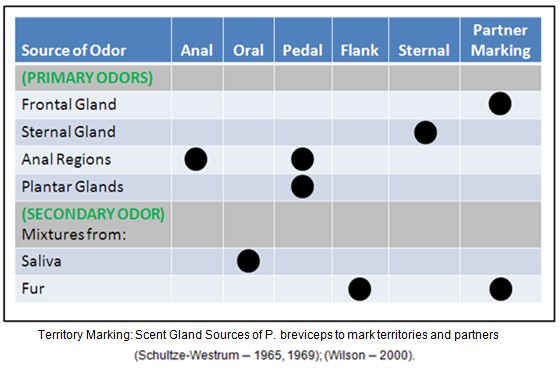Neutering will get rid of the musky scent of the sternal and frontal glands, but not all of the odors that gliders produce...
There are nine specialized glands that produce scents in sugar gliders:
1. [males] A sternal (chest) gland (musky)
2. [males and females] A pair of anal glands producing a white emulsion (acid smell)
3. [males and females] A second pair of anal glands secrete a clear viscid fluid
4. [females] sebaceous gland in the pouch (post-oestrous attractant)
5. [males and females] saliva (pheromones)
6. [males] frontal gland (top of head)
7. [males] proctodaeal gland (posterior alimentary canal)
8. [males and females] gland behind the ears
9. [males and females] inner angle of the eye
In addition to these glands, there is of course urine that both males and females use to mark territory.
Besides the Sternal gland in fertile males, both saliva and urine are used copiously by both males and females to mark territory.
The dominant scents are shown on this chart, adapted from the oft-quoted Schultze-Westrum study of 1965:

References:
Smith, M. "Peraurus Breviceps," Mammalian Species, no. 30, pp. 1-5, The American Society of Mammalogists, June 13, 1973.
Kean, R., "Behaviour and Territorialism in Trichosurus Vulpecula (Marsupialia)," Forest Research Institute, N.S. Forest Service, Wellington, Proceedings of the New Zealand Ecological Society
Volume: 14; Pages: 71-78, 1967.
Schultze-Westrum, T.G.; "Innerartliche Verstandigungdurch Dufte beim Glietbeutler Petaurus breviceps papuanus (Marsupialia, Phalangeridae) Z. Vergleich. Physiol. 50:151-220; 1965.
Schultze-Westrum, T.G.; "Social communication by chemical signals in flying phalangers (Petaurus breviceps papuanus)"; Pp. 269-277, in Olfaction and taste (C. Pfaffman, ed.) Rockefeller University Press, New York; 1969.
Wilson, E.O.; "Sociobiology, The New Synthesis," p. 205, 206, Harvard University Press, ISBN 0-674-00089-7, (c) 1975.